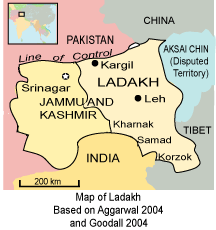Rapid urbanization in developing countries is often thought of as a lowland phenomenon caused by high birth rates in the rural areas, where people have to leave to get better-paying jobs. These stereotypes are not correct in Ladakh, where urbanization in Leh, the capital of the Buddhist region, has not proceeded according to many standard assumptions.
A recent journal article by Sarah K. Goodall analyzes the population trends and migrations from three different communities in the very high, pastoral section of southeast Ladakh. She finds that conditions vary from one community to the next, that reasons for migrating to Leh differ in each one, and that generalizations about rural to urban migration are difficult to make accurately.
She carried out census-type surveys and interviewed nomadic pastoralists in the Rupshu-Kharnak area, specifically the communities of Kharnak, Samad, and Korzok in 2000 and 2001. Rapid growth of the population in the rural areas does not explain migration tendencies. The interest in the article is the detail she provides about the pastoralists peoples of the three areas.

Kharnak has experienced a fairly significant migration of people to Leh, specifically to a community 10 km from the city know as Kharnakling. The migration has cut the population of the pastoral community in half. Interestingly, while migration to urban areas in other countries and regions is composed primarily of certain age groups, such as young people seeking jobs, the people in Kharnakling appear to represent an age-sex profile consistent with the community of origin. She explains that among pastoral people, participation of the entire family in the pastoral economy is critical for the success of the enterprise throughout much of the year, so entire families appear to stay together in the rural area or move to Leh.
Also, there do not appear to be significant economic advantages for the people from Kharnak to settle near Leh—wage incentives are negligible. Instead, long-term family goals, such as living close to a place where the children can get an education, may provide much more significant reasons for the migration. Goodall finds that 80 percent of the children in the immigrant community are attending, or have finished, their schooling.
Out-migration from the pastoral community of Samad has been somewhat less dramatic than from Kharnak, and the emigration has differed in character. The migrants live in a variety of neighborhoods of Leh and in some of the outlying villages. These people continue to tend their flocks in absentia, with help of family or friends who remain behind, so there is some seasonal, circular migration. Even after spending years in the Leh area, these families still maintain strong cultural and economic ties with Samad.
The third community the author studied, Korzok, differed from the other two in that very few residents had migrated to Leh. The presence of a very small village in the otherwise very rural, pastoral area of Korzok does not appear to be a factor in deterring out-migration.
While the scope of the brief journal article does not permit the author to make a detailed analysis of the reasons for the differing patterns of migration from the high-montane pastoral communities of Ladakh, she does conclude from her study that pastoralism is, in fact, a viable form of economy for the people of the region. It provides, she says, “a higher standard of living than subsistence farming (p.226).” She sees the pastoralism of the nomadic communities in Ladakh as an example of a positive strategy for managing life in the montane rangelands of the region.
Goodall, Sarah K. 2004. “Rural-to-Urban Migration and Urbanization in Leh, Ladakh: A Case Study of Three Nomadic Pastoral Communities.” Mountain Research and Development 24(3): 220-227.